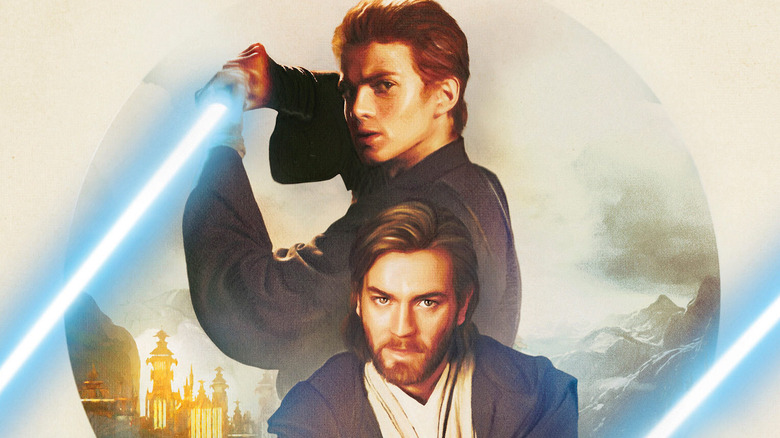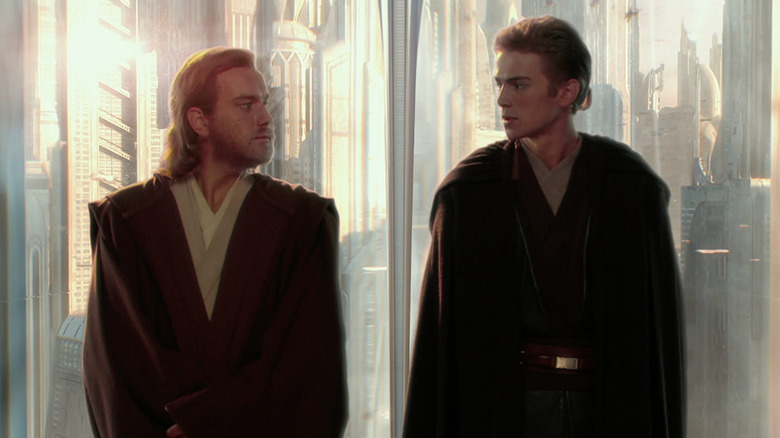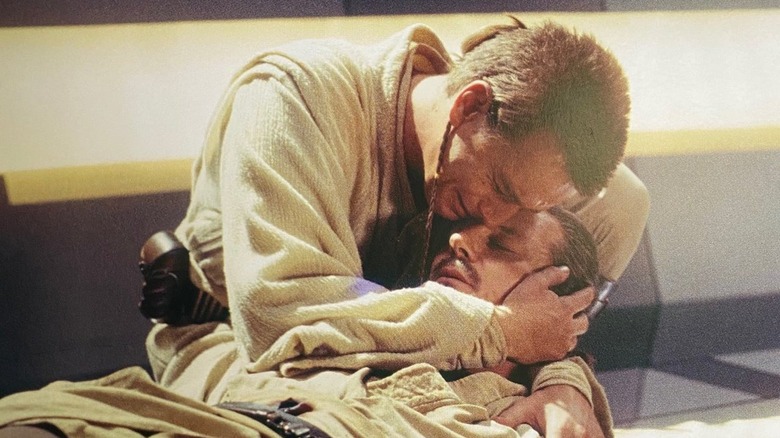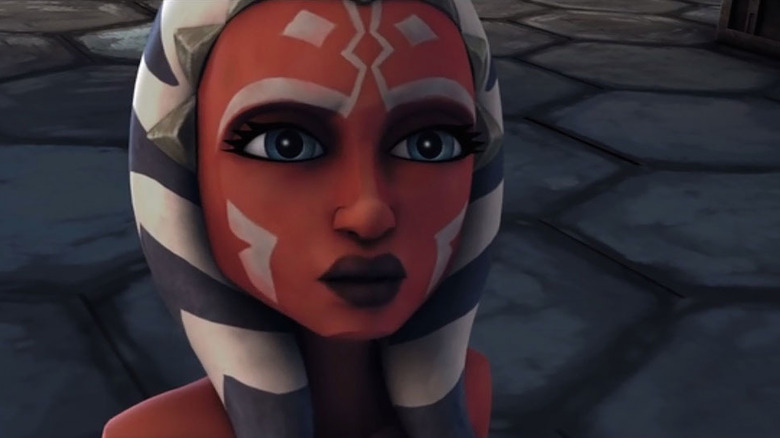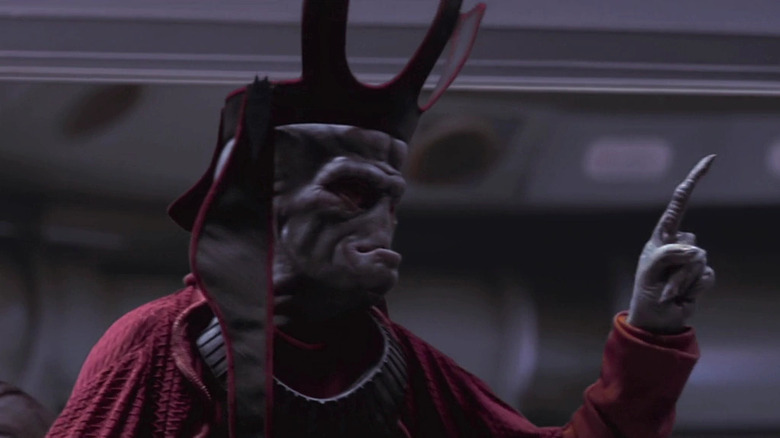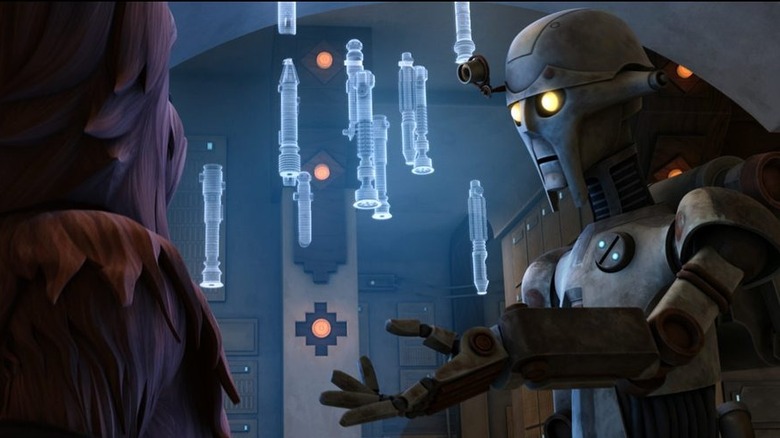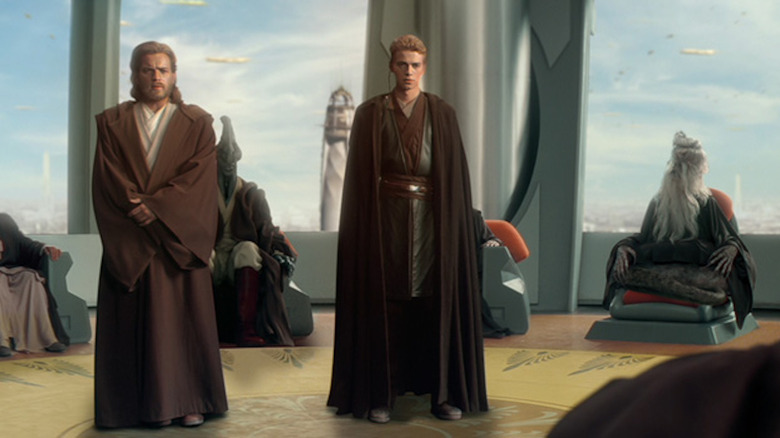Star Wars: Brotherhood Strengthens The Bonds Between Obi-Wan Kenobi And Anakin Skywalker
This will contain spoilers for "Star Wars: Brotherhood."
Mike Chen came onto the scene of "Star Wars" with a short story in the collection "From a Certain Point of View: The Empire Strikes Back," celebrating the 40th anniversary of the 1980 film. His dream project, though, was a prequel era book. And "Star Wars: Brotherhood" was born. "Brotherhood" tells the tale of a throwaway line in "Star Wars: Episode III – Revenge of the Sith."
"You owe me," Anakin tells Obi-Wan Kenobi, "and not for saving you skin for the 10th time."
"Ninth time," Obi-Wan responds. "That business on Cato Neimoidia doesn't ... doesn't count."
Set shortly after E.K. Johnston's book, "Star Wars: Queen's Hope," "Brotherhood" sees Anakin Skywalker's promotion to Jedi Knight and the relationship between he and Obi-Wan shift. When there's a terrorist attack on Cato Neimoidia, a system neutral between the Republic and the Confederacy, the Republic is accused of committing the crime. Obi-Wan Kenobi is sent on a diplomatic mission to get to the bottom of the plot. As part of the restrictions on his mission, he's allowed to come alone and not contact the Republic until the investigation is complete. Naturally, Anakin has other ideas and gives Obi-Wan a hidden communicator that would allow him to get in contact with his former Padawan in case of an emergency. When evidence points to the Republic being responsible for the destruction, things go from bad to worse.
Despite warnings that it would jeopardize the mission, Anakin launches into action to rescue Obi-Wan and offer him the support he needs. Because that's what Anakin does.
Since Count Dooku's mysterious agent, Asajj Ventress, is in the mix, anything can happen and the fate of the galaxy rests on the shoulders of these two Jedi brothers.
The relationship between Anakin and Obi-Wan
For Anakin and Obi-Wan, their time as master and apprentice felt contentious to a degree. As we saw in "Attack of the Clones," Anakin was impetuous and felt like Obi-Wan was holding him back. Mike Chen quite smartly shows us the shift in the relationship that gives us the more brotherly tone that we saw in "Star Wars: The Clone Wars" and the opening sequences of "Revenge of the Sith." It's Anakin's status as a Jedi Knight. Once Anakin and Obi-Wan were on more equal footing and not in power positions over each other, the two were able to act in a more jocular manner. That jocularity is really the basis for the parts of their relationship we know and love that make their break on Mustafar all the more heartbreaking.
The Skywalkers have a habit of taking off, half-cocked, into situations to save their loved ones. Anakin did that in "Attack of the Clones" to try to save his mother. Luke did that in "The Empire Strikes Back" to save Han and Leia. Anakin is given the chance to do that for Obi-Wan Kenobi here in "Brotherhood." Chen wraps up Anakin's motives into a story his mother told him about the Sun-Dragon of Tatooine. This was something that Matthew Stover explored in his excellent novelization of "Revenge of the Sith" and Chen expanded on in his story for "From a Certain Point of View: The Empire Strikes Back." The Sun-Dragon would fashion itself into a shield, guarding the things it cared about from the might of an exploding star. This is Anakin. It doesn't matter how destructive that shielding is, and it doesn't matter that Cato Neimoidia is a powder keg of diplomacy. When Anakin shows up and is likely to disrupt Obi-Wan's mission, Obi-Wan is still relieved to see his former apprentice.
Chen is able to deepen their relationship and add to it in ways that should make fans smile.
Qui-Gon's ghost
One thing running through the background of everything that has to do with Anakin Skywalker and Obi-Wan Kenobi is the ghost of Qui-Gon Jinn. This book is able to explore some of the haunting legacies and unanswered questions Qui-Gon left for these two. His influence is present in every page of this book as Anakin and Obi-Wan draw on the teachings of their master.
I don't feel like I've read a book or witnessed a Star Wars story that captures so well the impact Qui-Gon had on Anakin and Obi-Wan and in such drastically different ways. Chen also ties the two together in this realization late in the book and really hits it home, about how Qui-Gon really drew them together. Anakin and Obi-Wan struggled through their early days because Qui-Gon had put them together in some ways against their will. But as Anakin steps into the role of Jedi Knight and Obi-Wan steps onto the Jedi Council, free of the duties of mentoring Anakin as a padawan, their relationship blossoms in ways they realize Qui-Gon could see back in the day.
There are also more oblique references to Qui-Gon through Anakin. When Anakin is deep in meditation, it's strongly hinted that he can hear a voice like Qui-Gon's trying to guide him to the light. We heard hints of this in "Attack of the Clones," with Qui-Gon's anguished cries as Yoda senses Anakin killing the sand people, but this is the first acknowledgement we have that Anakin might hear such things. It would open another window into possibilities for how Anakin might have learned the path to immortality that he uses to come back to the light in "Return of the Jedi."
Mill Alibeth and Ahsoka Tano
One central character of the book is a Jedi Youngling named Mill Alibeth. She's a Zabrak (like Darth Maul or Eeth Koth) and is on the way to Ilum to find her first lightsaber crystal. But Mill can't do it. The thought of raising a lightsaber makes her physically ill and instead she refuses to obtain a lightsaber and Anakin brings her along on a mission of mercy in a war-torn land.
It's left to Anakin to guide her and convince her that she can both control the feelings she has in the Force and that she should remain in the Jedi order. It's a humanizing experience and they both learn from it. When Anakin races to Cato Neimoidia to rescue Obi-Wan, she backs him into a corner and outmaneuvers him into taking her, adding a terrific dynamic and point of view to the book.
Mill has a profound influence on Anakin, and Obi-Wan and Yoda are able to see this through the course of the novel. It wouldn't be a stretch to think that Mill might be why Yoda thought to assign Ahsoka Tano to Anakin later in the war as he's embroiled in the Battle of Christophsis.
Neimoidian monoliths
One thing I particularly enjoyed about this book is the deeper dive into Neimoidian culture. George Lucas suffered from criticism across all the "Star Wars" movies that cultures in his wide galaxy all seemed to be homogenous. It makes a certain sense when you have single biome planets, but it's definitely not the best. Over the years, there has been a lot of work to diversify the alien diversity in "Star Wars" and it's to Mike Chen's credit that he tackles that both obliquely in "Brotherhood" but also head on. There's a speech given by a Neimoidian character where they accuse the galaxy — particularly the Republic — about only knowing the stereotypes about Neimoidians, typecasting them as the greedy villains of the Trade Federation. But the Neimoidian culture is so much more than that, it has art and beauty and a rich history that people just don't even know about.
It's smart writing to reflect the galaxy far, far away, but also hold a mirror up to the world as we see it in real life. It's exactly the kind of stuff "Star Wars" does best when it's paying attention.
What to watch out for
Mike Chen packed references and Easter eggs into "Brotherhood" until it was bursting at the seams. For me, this isn't a bad thing.
Some of the big ones to watch out for would include the cameo from Joro Tapal and Cal Kestis as a young Padawan. Cal Kestis is the protagonist of "Star Wars Jedi: Fallen Order." Dexter Jettster, the four-armed Besalisk in charge of the diner on Coruscant and old friend of Obi-Wan's plays an important part of the narrative and we're given more glimpses into what their friendship is like.
Another character that makes a cameo is Sister, the trans Clone that first appeared in E.K. Johnston's "Queen's Hope." It would have been nice to see Sister on "Star Wars: The Clone Wars," but giving her multiple book appearances in the canon is still making me happy.
Another interesting name drop is the planet Valo, that has become a prominent spot in "The High Republic" series. There is no follow up on how it's doing after the events of "The Rising Star," but it's nice to see it's still in the universe.
This book also includes some firsts we hadn't seen in the canon before. It gives us Anakin's ascension to the role of Jedi Knight and the first meeting between Anakin, Obi-Wan, and Asajj Ventress. These two instances both overwrite the iterations of these things we saw in the Legends "Star Wars: Clone Wars" micro-series.
Perhaps the most surprising reference isn't a "Star Wars" one but "Doctor Who." Chen has the younglings talk of Huyang, the droid that accompanies them to the Gathering and helps them build their first lightsabers, crashing down in a blue box and arriving at the Jedi temple centuries earlier. On "Star Wars: The Clone Wars," Huyang was voiced by David Tennant (who won an Emmy for the role) and might be best known as the Tenth Doctor from "Doctor Who," making that blue box a not so subtle reference to the TARDIS. It put a smile on my face when I read that.
The verdict
This book was a delight to read and I devoured it. It has everything someone who loves Obi-Wan Kenobi and Anakin Skywalker could want. Mike Chen is clearly a fan of the material and relishes the chance to show us the pureness behind the Kenobi/Skywalker brotherhood. It blends equal parts of emotion and pathos with fun adventure serial action, but still manages to capture the lived-in feeling that "Star Wars" is so well known for.
It's fun.
And that's something "Star Wars" should be.
It's also about something — the non-toxic friendship between two equals who truly love each other.
And that's something "Star Wars" should be, too.
"Star Wars: Brotherhood" is available now at bookstores everywhere.
